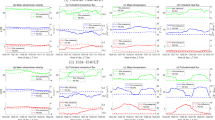Abstract
The widespread availability of detailed gridded topographic and bathymetric data for many areas of the earth has resulted in a need for efficient terrain effect computation techniques, especially for applications in gravity field modelling. Compared to conventional integration techniques, Fourier transform methods provide extremely efficient computations due to the speed of the Fast Fourier Transform (FFT. The Fourier techniques rely on linearization and series expansions of the basically unlinear terrain effect integrals, typically involving transformation of the heights/depths and their squares. TheFFT methods will especially be suited for terrain reduction of land gravity data and satellite altimetry geoid data.
In the paper the basic formulas will be outlined, and special emphasis will be put on the practial implementation, where a special coarse/detailed grid pair formulation must be used in order to minimize the unavoidable edge effects ofFFT, and the special properties ofFFT are utilized to limit the actual number of data transformations needed. Actual results are presented for gravity and geoid terrain effects in test areas of the USA, Greenland and the North Atlantic. The results are evaluated against a conventional integration program: thus, e.g., in an area of East Greenland (with terrain corrections up to10 mgal), the accuracy ofFFT-computed terrain corrections in actual gravity stations showed anr.m.s. error of0.25 mgal, using height data from a detailed photogrammetric digital terrain model. Similarly, isostatic ocean geoid effects in the Faeroe Islands region were found to be computed withr.m.s. errors around0.03 m
Similar content being viewed by others
References
L.M. DORMAN and T.R. LEWIS: The use of nonlinear functional expansions in calculation of the terrain effect in airborne and marine gravity and gradiometry. Geophysics,39, No. 1, pp. 33–38, 1974.
R. FORSBERG and C.C. TSCHERNING: The-Use of Height Data in Gravity Field Approximation by Collocation. Journ. Geoph. Res.,86, No. B9, pp. 7843–7854, 1981.
R. FORSBERG: A study of terrain reductions, density anomalies and geophysical inversion methods in gravity field modelling. Rep. 355, Dept. Geod. Sci. Surv., Ohio State Univ., Columbus, 1984.
E.R. KANASEWICH: Time Sequence Analysis in Geophysics. The University of Alberta Press, second ed., Edmonton 1975.
H. MORITZ: On the use of the terrain correction in solving Molodensky's problem. Rep. 108, Dept. Geod. Sci., Ohio State Univ., Columbus, 1968.
R.L. PARKER: The rapid calculation of potential anomalies. Geophys. J.R. Astr. Soc.,31, pp. 447–455, 1972.
R.H. RAPP: Degree variances of the earth's potential, topography and its isostatic compensation. Bull. Geod.,56, pp. 84–94, 1982.
M.G. SIDERIS: A Fast Fourier Transform method for computing terrain corrections. Manuscripta Geodaetica,10, pp. 66–73, 1985.
C.C. TSCHERNING: Geoid Modeling Using Collocation in Scandinavia and Greeland. Marine Geodesy,9, No. 1, pp. 1–16, 1985.
Author information
Authors and Affiliations
Rights and permissions
About this article
Cite this article
Forsberg, R. Gravity field terrain effect computations by FFT. Bull. Geodesique 59, 342–360 (1985). https://doi.org/10.1007/BF02521068
Received:
Accepted:
Issue Date:
DOI: https://doi.org/10.1007/BF02521068




